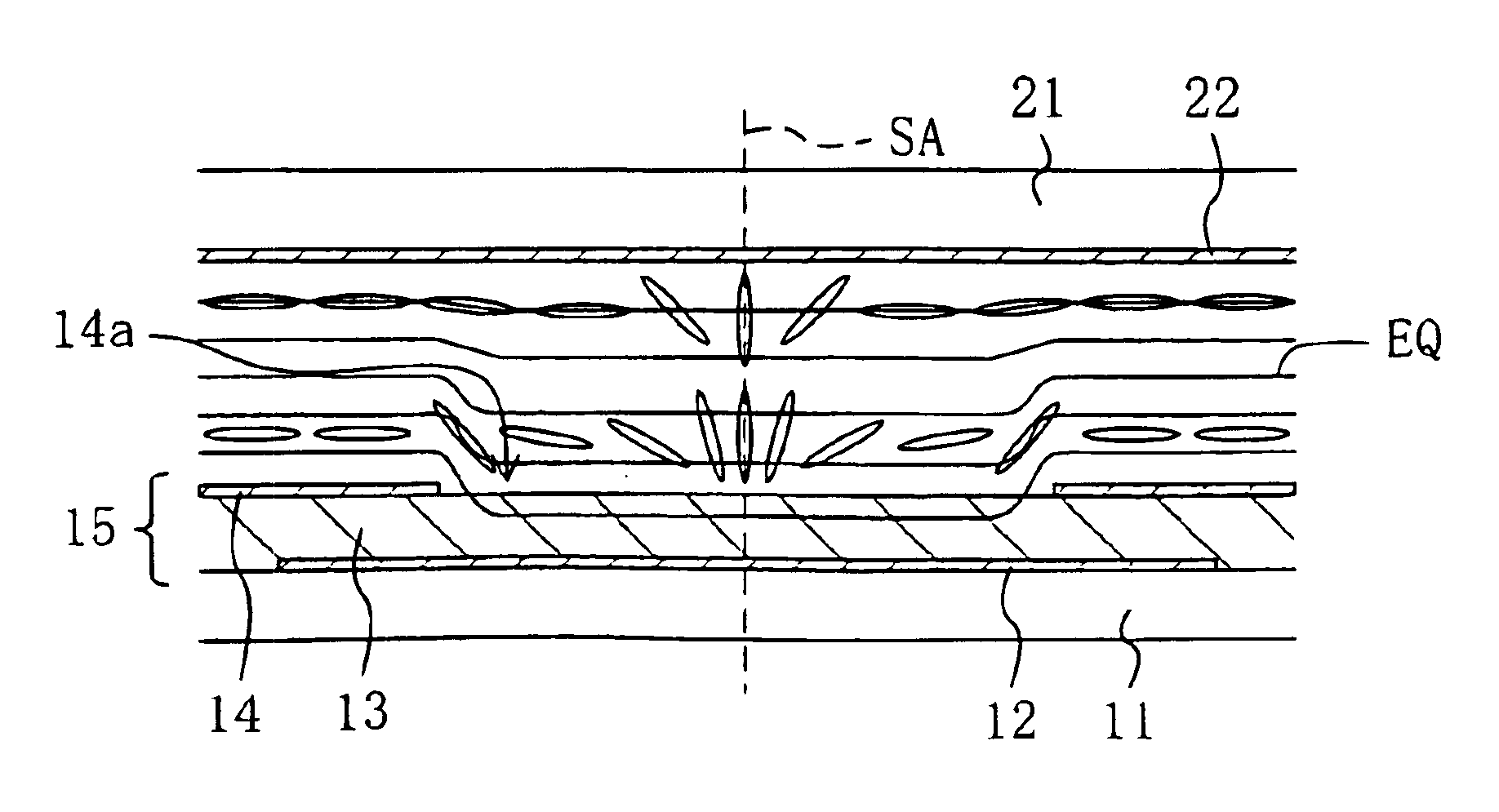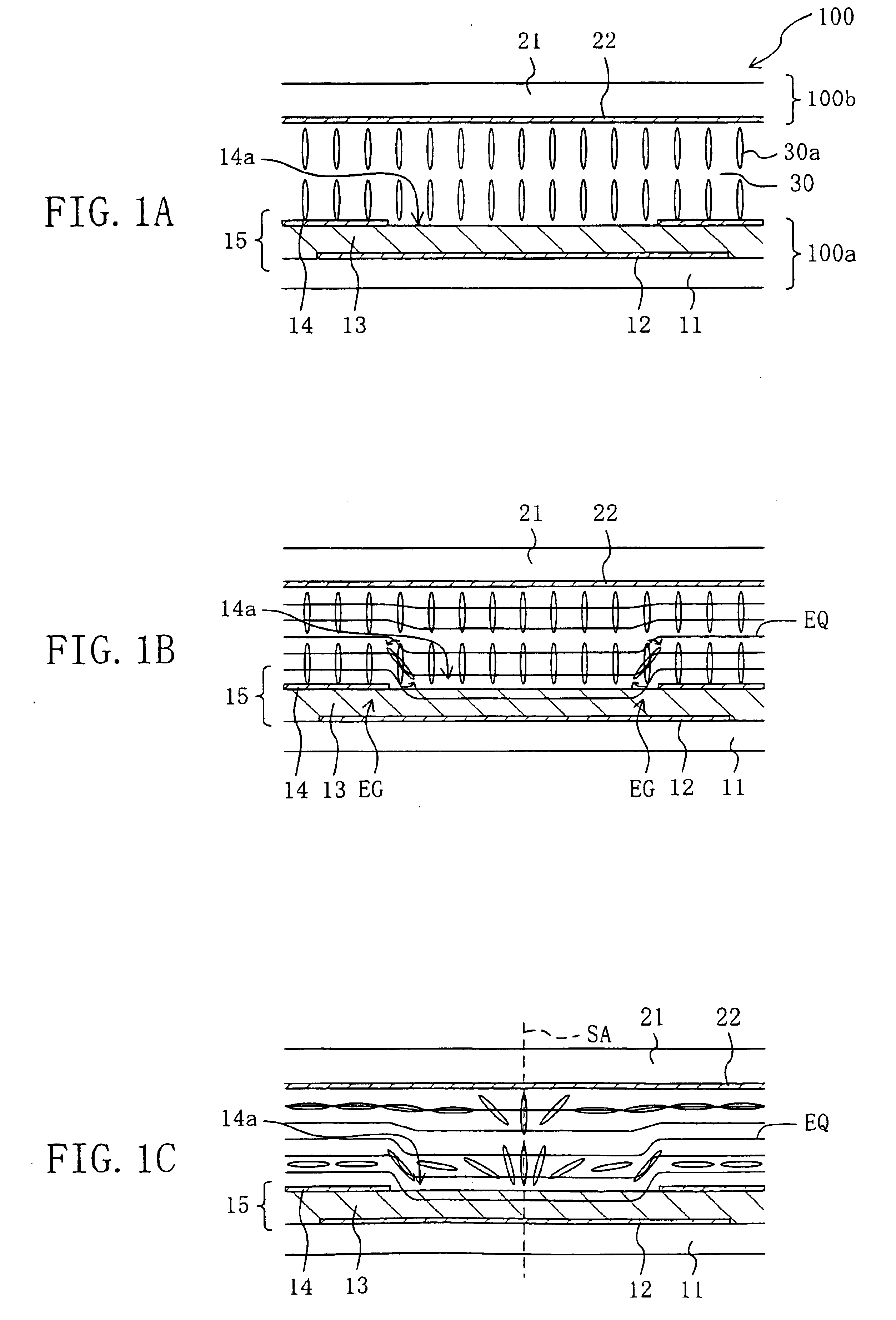Liquid crystal display device
a liquid crystal display and display device technology, applied in non-linear optics, instruments, optics, etc., can solve the problems of difficult to realize stable production of the device, narrow viewing angle of conventional twist nematic and super twist nematic liquid crystal display devices, and high risk of rubbing streaks in the displayed image, etc., to achieve the effect of suppressing voltage drop
- Summary
- Abstract
- Description
- Claims
- Application Information
AI Technical Summary
Benefits of technology
Problems solved by technology
Method used
Image
Examples
embodiment 1
[0134]First, the electrode structure of the liquid crystal display device of the present invention and the function thereof will be described. The liquid crystal display device of the present invention has desirable display characteristics and is therefore suitably used as an active matrix type liquid crystal display device. While the preferred embodiments of the present invention will be hereinafter described with respect to an active matrix type liquid crystal display device using thin film transistors (TFTs), the present invention can alternatively be used with an active matrix type liquid crystal display device using an MIM (metal-insulator-metal) structure, or a passive matrix type liquid crystal display device. Moreover, while the preferred embodiments of the present invention will be described with respect to a transmission type liquid crystal display device, the present invention can alternatively be used with a reflection type liquid crystal display device or even with a tr...
embodiment 2
[0244]The structure of one picture element region of a liquid crystal display device 400B according to Embodiment 2 of the present invention will now be described with reference to FIG. 23A and FIG. 23B. In the subsequent figures, each element having substantially the same function as that of the liquid crystal display device 400 illustrated in FIG. 11A to FIG. 11c will be denoted by the same reference numeral and will not be further described. FIG. 23A is a plan view as viewed in the substrate normal direction, and FIG. 23B is a cross-sectional view taken along line 23B-23B′ of FIG. 23A. FIG. 23B schematically illustrates a state where no voltage is applied across the liquid crystal layer.
[0245]As illustrated in FIG. 23A and FIG. 23B, the liquid crystal display device 400B is different from the liquid crystal display device 400A of Embodiment 1 illustrated in FIG. 15A and FIG. 15B in that a TFT substrate 400b of the liquid crystal display device 400B includes a protrusion 40 in the...
embodiment 3
[0271]In the liquid crystal display device of Embodiment 1 described above, a two-layer electrode is employed for one (the picture element electrode 15 in the illustrated example) of the picture element electrode 15 defining picture element regions and the counter electrode 22 opposing each other via the liquid crystal layer 30, and the openings 14a are provided in the upper conductive layer 14, so that an inclined electric field is produced in the presence of an applied voltage, thereby orienting the liquid crystal molecules into a radially-inclined orientation by using the inclined electric field. In the liquid crystal display device of Embodiment 2, the protrusion is provided in the opening 14a of the upper conductive layer 14 so as to stabilize the radially-inclined orientation.
[0272]Embodiment 3 is a liquid crystal display device including a further orientation-regulating structure provided on the substrate (the counter substrate in the examples described above) which is differ...
PUM
 Login to View More
Login to View More Abstract
Description
Claims
Application Information
 Login to View More
Login to View More - R&D
- Intellectual Property
- Life Sciences
- Materials
- Tech Scout
- Unparalleled Data Quality
- Higher Quality Content
- 60% Fewer Hallucinations
Browse by: Latest US Patents, China's latest patents, Technical Efficacy Thesaurus, Application Domain, Technology Topic, Popular Technical Reports.
© 2025 PatSnap. All rights reserved.Legal|Privacy policy|Modern Slavery Act Transparency Statement|Sitemap|About US| Contact US: help@patsnap.com



